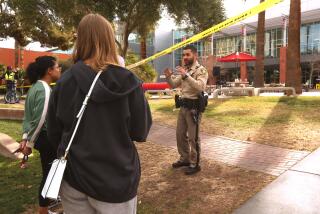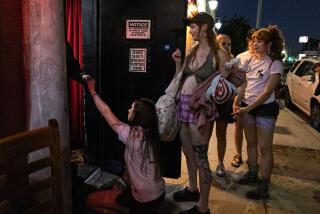College credit too
- Share via
Las Vegas — THE strobe lights were spinning, the hip-hop was thumping and the young well-dressed women at a ringside table were alternately screaming and laughing as seven Australian studs in the Excalibur hotel’s Thunder From Down Under strip revue tore off their clothes and gyrated through the audience.
To an outsider, it looked like a typical girls’ night out, except that the dozen or so women looking on weren’t drinking. Some were taking notes for their Sex, Dance and Entertainment class at the University of Nevada Las Vegas.
A class exploring the sexual aspects of dance may sound like the Vegas version of Basket Weaving 101. But field trips to strip clubs, lectures by lap dancers and videos of breast-enlargement surgery are all part of a curriculum bridging the gap between academia and the outrageous outside reality of the Strip, just a stone’s throw away.
“Sometimes, I think universities are too involved with history and not enough with what’s actually happening,” said Garold Gardner, the 66-year-old dance instructor who teaches the class. “Courses that are more cutting-edge, that have more to do with now, are very important for the curriculum of any department.”
It’s a philosophy UNLV seems to have wholeheartedly embraced. In recent years, the school’s sociology department has added a class on the Sociology of the Sex Industry. And the Women’s Studies program now offers a course on Porn in the USA.
Sex, Dance and Entertainment is merely following a trend in higher education, one that has seen more and more colleges and universities around the country offering classes in sexuality, pornography, even pedophilia.
“There’s always been classes on erotica, whether it was in art, literature, sexuality,” said James Elias, director of Cal State Northridge’s Center for Sex Research. “Some of the [classes that] are coming up now have to do with the changing social scene. As we’ve moved out of an era of Doris Day and Rock Hudson, we see erotica moving in to the mainstream and that makes it more of a topic for study.”
UNLV’s course may be “viewed as one of those clever classes, but all of them have a solid academic base,” said Louis Kavouras, chairman of the Las Vegas university’s dance department. Kavouras said he hasn’t received any complaints about the class from university administrators, students or anyone off campus. More than anything, he said, the topic just piques their interest.
Offered through the school’s dance department but geared toward nondance majors, the course has become increasingly popular in the three years it’s been offered. What started as one section with about 50 students has grown into three separate classes of 35 each.
To students and faculty at other universities, it may not seem at all normal to experience, in the name of education, an onstage lap dance by a longhaired pretty boy with six-pack abs, as Haning did during the field trip to Thunder From Down Under. But Las Vegas is so unusual that some university faculty members felt they could take advantage of the city’s anything-goes environment to teach students a lesson.
“We have so many people that come to the university who want to learn about what they see on TV and in films and the strip shows,” said Carol Rae, the UNLV dance instructor who came up with the idea. “We felt there was a need for it, since we’re the center of entertainment here.”
The class, Rae is careful to point out, isn’t all about showing skin. The first half of the semester is historical, tracking how dance has changed as society’s mores have changed. It begins in 1900, examining dances including the waltz and polka, during which couples barely touched, and continues through to the so-called dirty ancing of today’s pop superstars.
Unlike many of the more traditional dance classes at UNLV, Sex, Dance and Entertainment is not a how-to, although a couple of years ago, Rae said a few students got interested in becoming strippers after seeing a striptease act as part of their course work. Rae was concerned that the class might be pushing some students in the wrong direction.
“It’s not that I say ‘no’ about it, but I thought we’ve got to be careful how we present this,” she said. “We’ve got to present the negative part.”
A video on Studio 54, for example, doesn’t just focus on the music and dancing at the famed New York discotheque, but also on the drug use that was prevalent there; a video about stripping shows a dancer’s insecurity about her weight and subsequent liposuction surgery. Guests who speak to the students are also encouraged to be absolutely honest.
During class the day after the Thunder From Down Under show, two dancers from the revue were speaking to the students, whose homework was to prepare two questions.
While some appeared to have put little thought into it, the class eventually evolved into thoughtful discussions about job security and how significant others deal with the hands-on nature of the job.
Marcin Glinka, a 19-year-old student, wanted to know how the audience reacted to the dancers’ first show, but, “first of all,” he said, “I want to tell you I went home last night and did 100 push-ups.”
More to Read
Sign up for Essential California
The most important California stories and recommendations in your inbox every morning.
You may occasionally receive promotional content from the Los Angeles Times.













